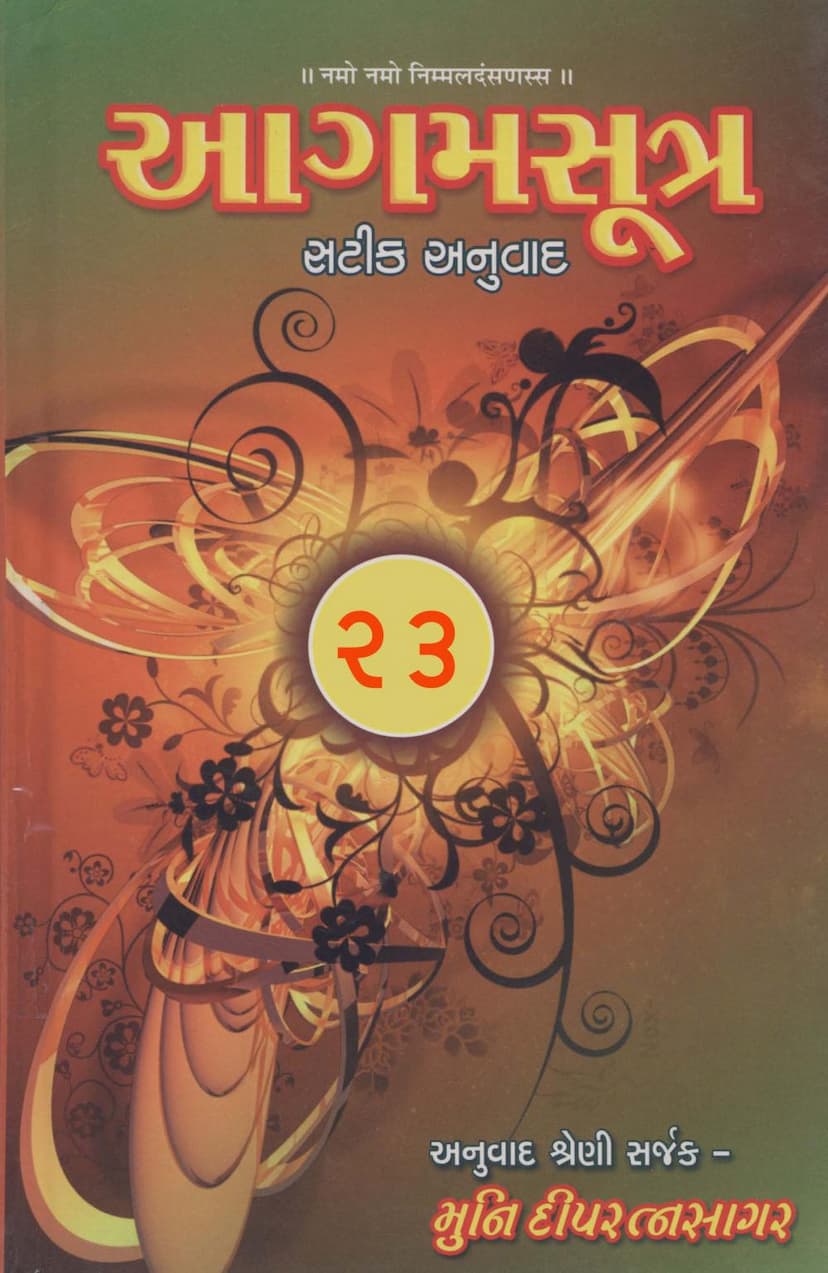Agam Satik Part 23 Suryapragnapti Sutra Gujarati Anuwad 1
Added to library: September 1, 2025

Summary
This document is the 23rd volume in a series of "Agam Satik Anu-vaad" (Agam Sutras with Commentary and Translation), specifically focusing on the Suryaprajnapti Sutra, which is the fifth Upanga Sutra in Jain tradition. The original text is in Prakrit, and this volume provides a Gujarati translation and commentary.
Here's a breakdown of the key information and content:
Title: Agam Satik Anu-vaad (Volume 23) Original Text: Suryaprajnapti Sutra (also known as Suryapannatti in Prakrit, and Suryapragnapti in Sanskrit and Gujarati) Author of Translation/Commentary: Muni Deepratnasagarji Publisher: Deepratnasagar Content Covered in this Volume:
- This volume contains the first part of the Suryaprajnapti Sutra.
- The text is primarily related to Ganitanuyoga (cosmology and mathematics within Jainism).
- The chapters are identified by the term "Prabhrit" (beginning with Prabhrit 1) and sub-sections within them as "Prabhrit-Prabhrit" (up to Prabhrit-Prabhrit 18 in this volume).
- The volume covers Prabhrit 1 to Prabhrit 10, and Prabhrit-Prabhrit 1 to Prabhrit-Prabhrit 18.
- It mentions that Volume 24 will cover Prabhrit 11 to Prabhrit 20 and also include information related to Chandraprajnapti.
- A notable point is that the Suryaprajnapti and Chandraprajnapti Sutras are considered to have identical subject matter in current times, with the reason for their potential merging over time being unknown. The commentary by Malayagiri is also the same for both.
Key Themes and Subjects (as indicated by the detailed breakdown):
The detailed sutra and commentary sections reveal the text delves into astronomical and cosmological subjects, including:
- The Sun's Movement: Its journey through different "mandals" (spheres or orbits), its speed, its path, and its illumination of various regions.
- Cosmic Structure: Discussions about Jambudvipa, its dimensions, the measurement of its circumference, and the concept of "chakravart" regions.
- Time and Cycles: Calculations related to time, such as "muhurts" (time units), "ahoratra" (day and night), "masa" (months), "ritu" (seasons), "ayana" (solstices), "samvatsara" (years), and "yuga" (eras).
- Light and Shadow: The extent of light and shadow cast by the sun, and the concept of "porushi chhaya" (shadow cast by a human figure).
- Different Theories: The text presents various philosophical viewpoints or theories from different schools of thought regarding celestial phenomena, which are then debated and refuted to establish the Jain perspective.
- Deities associated with Nakshatras: The text also lists the deities associated with each Nakshatra.
- The Sun's Trajectory and its effects: Detailed discussions on how the sun's position and movement affect the length of day and night, and the distribution of heat and light across different regions.
- The Sun's Path and its relationship with Nakshatras: How the sun's movement aligns with the lunar mansions.
- The concept of "Leysya" (color or disposition) of the Sun: The text explores where the sun's Leysya is affected or extinguished.
- The Sun's path and its interaction with celestial bodies: Discussions on the sun's interaction with celestial spheres and other cosmic elements.
- The Sun's motion and its impact on day and night length: Detailed explanations of how the sun's movement affects the duration of day and night across different regions and times of the year.
- The Sun's heat and its distribution: Explanations on how the sun's heat ("tapkshetra") is distributed and measured.
- The Sun's position and its influence on shadow ("pourushi chhaya"): The text discusses how the sun's position affects the length and nature of shadows.
- The Sun's cyclical journey: The text elaborates on the sun's movement through various celestial spheres and its cyclical nature.
Overall Purpose:
This volume, like others in the series, aims to provide a comprehensive and accessible translation and commentary of the foundational Jain scriptures, making complex astronomical and cosmological knowledge understandable to a wider audience. The detailed explanations and discussions of various theories highlight the intellectual depth of Jain cosmology.
The extensive acknowledgments of donors and supporting organizations (pages 3-8) underscore the effort and collaborative nature of this publication project, emphasizing the importance placed on preserving and disseminating these ancient texts. The latter part of the document (pages 8-10) lists other publications by the same author and publisher, showcasing a vast body of work related to Jain Agamas and philosophy.